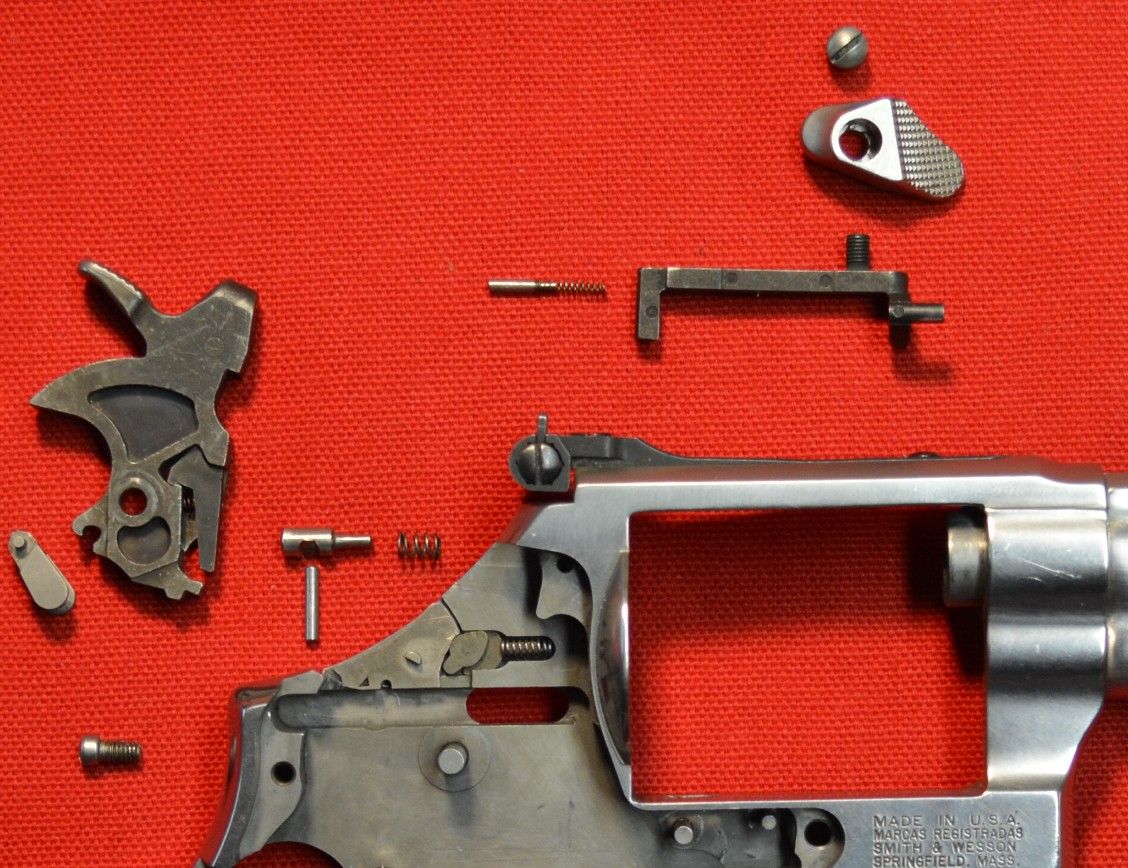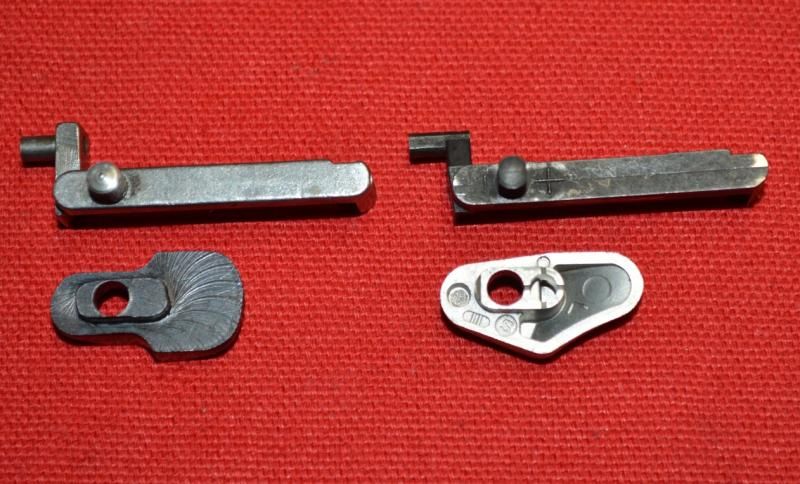
 |
|
|||||||
| Forum Rules | Firearms Safety | Firearms Photos | Links | Library | Lost Password | Email Changes |
| Register | FAQ | Calendar | Today's Posts | Search |
 |
|
|
Thread Tools | Search this Thread |
|
|
#1 |
|
Member
Join Date: September 25, 2015
Posts: 55
|
Another stupid question (S&W cylinder release rubbing frame)
I know I’m probably the last person that anybody wants to hear from on these forums, so I apologize. Anyway, I just noticed rubbing marks right in front of the cylinder release that weren’t there before today. I’m not sure if some dirt just got in there when I went to open the cylinder once and scratched it, but I can’t get the cylinder release to touch the frame again. What I did notice was that when I push down (not forward) on the cylinder release where the knurling is, it makes a clicking sound. I took the cylinder release off and saw the little threaded bar that it screws on to and its what is making the clicking sound; not a loose fitting thumb piece.
Not sure if the cylinder release is supposed to have downward play or not, but can anybody with a S&W revolver tell me if theirs makes the same clicking when they press down on it? I also took this short video of me operating the cylinder release. https://youtu.be/jzmpXZ8xshA It looks like the front of the cylinder release moves downward as I push it forward. I’m not sure if that’s how all of them are, or if it should stay at one height throughout the entire forward motion. Last edited by TestedTwice; February 14, 2019 at 07:32 AM. |
|
|
|
|
#2 |
|
Senior Member
Join Date: January 3, 2014
Location: Land of the Pilgrims
Posts: 2,033
|
Howdy
The little threaded bar you are referring to is called the Cylinder Bolt. Not to be confused with the Cylinder Stop which rotates on a stud below the cylinder to lock the cylinder in battery. In this photo of a disassembled Model 617-6 the Cylinder Bolt and its associated parts can be seen above the frame. The Cylinder Bolt rides in the long slot milled into the frame. Be very careful if you decide to remove the Cylinder Bolt. There is a very small spring and plunger that sit in a hole at the rear of the Cylinder Bolt. They keep the bolt in the forward position when the cylinder is open. This is a safety feature, it prevents the action from being worked if the cylinder is open. If you don't know they are there, and remove the Cylinder Bolt from the frame, the spring and plunger will probably fly off to parts unknown. Trust me on this. When removing the Cylinder Bolt, keep your thumb over the rear to prevent the spring and plunger from flying out. Gently relieve the pressure of the spring so you can pluck it and its plunger out.  The Thumb Piece (what you called the cylinder release) is designed so it does not contact the frame. I don't know what specific model you have, but I can tell from your video it is a modern one. This photo shows one of the old machined Thumb Pieces and and Cylinder Bolt from the pre-MIM days on the left, and the analogous MIM parts that are in your revolver on the right. Notice the raised boss on the underside of the Thumb Pieces. When you snug up the nut that holds the Thumb Piece to the Cylinder Bolt, the raised boss extends through the slot in the frame and bottoms on the Cylinder Bolt. These parts are designed so that when they are snugged up the Cylinder Bolt will ride in its slot in the frame, and the Thumb Piece will not contact the outside of the frame. The height of the boss controls this. There will always be a little bit of clearance. I just grabbed several of my Smiths, and the amount of clearance between the underside of the Thumb Piece and the frame varied. Just a couple of thousandths on some, a bit more on others. But the Thumb Piece did not contact the frame on any of them. They are designed this way specifically so the Thumb Piece will not scratch the blue (or the stainless finish) on the frame. If your frame is scratched, some crud got in there and scratched the frame.  In theory, the slot the Cylinder Stop rides in should be perfectly parallel to the outside of the frame. So when the Thumb Piece rides back and forth it should always stay the same distance away from the frame. In practice, the slot may not be perfectly parallel, so the Thumb Piece may get closer to the frame at one end of its travel than at the other end. A little bit of play is completely normal. The clicking you hear is probably just the Cylinder Stop bouncing over a small burr somewhere. I would not worry about it at all, I noticed some slight clicking in some of my old Smiths too. About the scratches, just make sure no crud gets under the Thumb Piece. The scratches won't show up so much on a Stainless frame as they would on a blued frame. If it really bothers you you can take it apart and buff out the scratches, but I wouldn't bother. Last edited by Driftwood Johnson; February 14, 2019 at 12:31 PM. |
|
|
|
|
#3 | |
|
Senior Member
Join Date: May 31, 2007
Location: NC
Posts: 2,614
|
Quote:
Some time ago, a number of us showed up at IDPA Nationals with match-tuned revolvers that were converted to DAO by lobbing off the back half of the hammer, which included the portion that interacts with the cylinder bolt. At the safety inspection, they nearly freaked and, despite protesting there was nothing in the rulebook about it, and that a revolver is out of battery when the cylinder's open anyway, they considered DQing us. In the end, they decided to let us shoot the rest of the match, and told us to "get that revolver fixed, pronto"  . Sure enough, the version of the rulebook explicitly stated the action can't be cycled with the cylinder open. . Sure enough, the version of the rulebook explicitly stated the action can't be cycled with the cylinder open. 
|
|
|
|
|
|
#4 | |
|
Senior Member
Join Date: January 3, 2014
Location: Land of the Pilgrims
Posts: 2,033
|
Quote:
It always seemed to me that if the lockwork cannot be operated on a S&W while the cylinder is open, one could not load rounds into the chamber with the hammer cocked, and have an accidental discharge by closing the cylinder with the gun loaded and the hammer cocked. With a Colt, one can do that. However I am playing around with an old Police Positive right now, and although I can cock the hammer while the cylinder is open, I can't really close the cylinder because the hand is sticking out and preventing the cylinder from closing. Anyway, I always felt S&W added the feature of the action being locked while the cylinder was open as a safety feature. Just my own opinion I guess. Yes, we all know this feature on a S&W can be defeated by holding the thumpiece back while the cylinder is open. Playing with a K frame Smith right now. With the cylinder open I can hold the thumbpiece back and cock the hammer. Then I can close the cylinder while the hammer is still cocked. The hand does not protrude enough to prevent the cylinder from closing, and besides it is on the other side of the frame than with a Colt. So if I defeat the 'safety feature' of the S&W it is entirely possible to close a loaded cylinder while the hammer is back. Then, sloppy trigger technique could theoretically cause an accidental discharge. Yeah, I know the best safety device is between our ears, and all that stuff................ Last edited by Driftwood Johnson; February 15, 2019 at 03:14 PM. |
|
|
|
|
|
#5 |
|
Senior Member
Join Date: November 30, 2012
Location: Baton Rouge, Louisiana
Posts: 1,752
|
The operational video was great but can you post a photo or two of these "rubbing marks" you are concerned about.
When I press down on the cylinder release I do hear a tiny sound...it's just the part moving in. When I press it forward you hear the unlatching...parts are moving. The latch moves parallel to the frame. Latch movement is only 1/8th inch at most in my J frame ....that's not a lot. I watched your video again carefully and I don't see anything out of the ordinary. The latch movement is normal....I wouldn't be concerned ...revolvers do get rub marks from parts that have close tolerances... It's OK . Gary |
|
|
|
|
#6 | |
|
Senior Member
Join Date: May 31, 2007
Location: NC
Posts: 2,614
|
Quote:
|
|
|
|
|
|
#7 |
|
Senior Member
Join Date: June 1, 2013
Location: Now relocated to Texas
Posts: 2,943
|
Personally I find it hard to understand a person becoming so concerned with a small wear mark where you have a piece of metal moving on top of the surface. Moving parts cause wear and if you fire the pistol other areas of wear, no matter how insignificant are bound to appear, are we going to have a post when the cylinder stop makes a telltale line around the cylinder? Marks and residue on the cylinder face? Extractor rod scratches from ejecting cases? I shoot my weapons and acknowledge the fact they will not look new forever.
|
|
|
|
|
#8 |
|
Senior Member
Join Date: May 31, 2007
Location: NC
Posts: 2,614
|
As far as I can tell, the OP didn't express any concerns about cosmetics. They were simply asking if this is an acceptable condition, since, for all they know, it might be a sign of a functional issue.
|
|
|
|
|
#9 |
|
Senior Member
Join Date: October 28, 2009
Posts: 156
|
I always assumed that the action locked to keep you from closing the cylinder with the hammer cocked....the hand would be exposed and might get damaged if the ratchet wasn't lined up just right. But that is just an my assumption.
|
|
|
 |
|
|